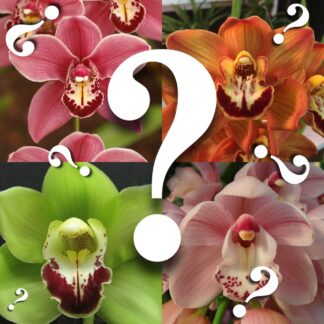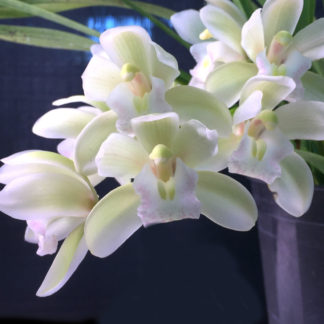Description
IMPORTANT NOTE: these plants are NOT IN BUD/BLOOM when shipped. PLEASE look at all the pictures in this listing so you know the condition/size of plant you’ll be getting.
Cymbidium Misaki’s Dream ‘Starman’
QUICK FACTS:
Easy to grow, easy to bloom Cymbidium. Great for new orchid growers!
Flower fragrance like freshly-cut watermelon
Warm and cold-tolerant (avoid temps below 30 F). Grow in moderate to bright shady conditions. Water 2 – 3 times/week. Orchid bark (fir bark) media/soil works very well for Cymbidium orchids.
IMPORTANT NOTE: these plants are NOT IN BUD/BLOOM when shipped. PLEASE look at all the pictures in this listing so you know the condition/size of plant you’ll be getting. Plants shipped BARE ROOT (unless you order IN POT)
==========================
There’s a starman waiting in the sky /
He’d like to come and meet us /
But he thinks he’d blow our minds /
There’s a starman waiting in the sky /
He’s told us not to blow it /
Cause he knows it’s all worthwhile /
He told me: /
Let the children lose it /
Let the children use it /
Let all the children boogie /
Get ready to boogie: this orchid will blow your mind.
So fifty years since this song came out and we’re still listening to David Bowie and reeling from his effect on pop culture. Check out Season 3 Episode 9 of The Crown, when the brilliantly acted, scene-stealing Princess Anne (played by Erin Doherty) drives back to Buckingham Palace singing along with Bowie’s Starman blaring away on the radio-oh-oh. A fine moment in the general vast wasteland of TV.
Cym. Misaki’s Dream ‘Starman’ is the product of Yai x Pywacket. Yai has been an excellent parent in Cymbidium breeding, as it confers an intensely red lip to its progeny. Interestingly, some flowers on an inflorescence (but not all) will have bloody lips, which indicates some interesting genetics going on. Pywacket, being 50% tracyanum species, confers tolerance to freezing temps AND fragrance. ‘Starman’ blooms smell very much like freshly-cut watermelon – quite distinctive from other fragrant Cyms.
Easy to grow, easy to bloom, lovely custard-yellow flowers, and fresh fragrance. So get this orchid, and then listen to David Bowie’s Starman.
…La-la-la-la-la-la-la-la-la-la-la-la…
ABOUT CYMBIDIUMS AND WHY THEY’RE GREAT
Cymbidium orchids are one of the most popular orchid types grown in the world.
Many excellent qualities make them favorites in the flower world:
COLORFUL FLOWERS — Breeders have done an excellent job producing an incredible variety of colors. Colors, spots, splashes: cymbidium blooms have them all.
SHOWY FLOWER SPIKES — Some types hold their spikes erect with big, round flowers and others produce pendulous spikes with graceful arching flowers.
LOTS OF FLOWERS — Some varieties can have 30+ flowers on a single spike! Most modern hybrids have at least ten.
LONG-LASTING BLOOMS — Many modern Cymbidium blooms stay open for two months (or more!).
EASY TO GROW — I usually recommend using reverse osmosis/rainwater/distilled water on orchids when possible, but Cymbidiums don’t seem to need it. They grow outside in non-freezing zones and are used as landscape plants and get the same water as all the other plants. (Of course, using RO/rainwater/distilled doesn’t hurt!)
EASY TO BLOOM — Cymbidiums are not fussy about blooming. They bloom regularly year after year, unlike a lot of other orchids who take up room and board but don’t bloom or do much else! Sort of like kids these days.
HARDY — A mature Cymbidium is a beast of plant. Big, tough bulbs, and thick, stiff leaves make them tough plants that can handle a lot. No shrinking violets, these!
HOW TO GROW THIS CYMBIDIUM
Cymbidium orchids are among the easiest orchids to grow. They grow well in chunky orchid bark (fir bark typically), or thoroughly rinsed coconut husk. Avoid overpotting (i.e., putting the plant in a pot that is too big) — select a pot that is not too snug but also leaves room for growth. Make sure your pot has drainage holes at the bottom. Water twice per week, and fertilize lightly every week or so with any balanced fertilizer. For smaller plants, avoid frost; larger plants can handle near freezing temperatures, but do not leave outside if you grow in an area that gets snow. For blooming size plants (usually three growths/bulbs), allow the plant to experience cooler temperatures (in the 40s F) to set the bud the following season. Larger plants can handle bright light, but younger plants should be grown in bright shade or allowed to receive diffuse light.






